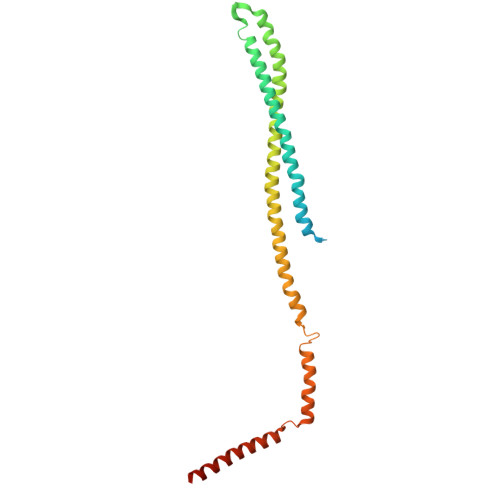Structural plasticity of bacterial ESCRT-III protein PspA in higher-order assemblies.
Junglas, B., Hudina, E., Schonnenbeck, P., Ritter, I., Heddier, A., Santiago-Schubel, B., Huesgen, P.F., Schneider, D., Sachse, C.(2024) Nat Struct Mol Biol
- PubMed: 39152237
- DOI: https://doi.org/10.1038/s41594-024-01359-7
- Primary Citation of Related Structures:
8AKQ, 8AKR, 8AKS, 8AKT, 8AKU, 8AKV, 8AKW, 8AKX, 8AKY, 8AKZ, 8AL0 - PubMed Abstract:
Eukaryotic members of the endosome sorting complex required for transport-III (ESCRT-III) family have been shown to form diverse higher-order assemblies. The bacterial phage shock protein A (PspA) has been identified as a member of the ESCRT-III superfamily, and PspA homo-oligomerizes to form rod-shaped assemblies. As observed for eukaryotic ESCRT-III, PspA forms tubular assemblies of varying diameters. Using electron cryo-electron microscopy, we determined 61 Synechocystis PspA structures and observed in molecular detail how the structural plasticity of PspA rods is mediated by conformational changes at three hinge regions in the monomer and by the fixed and changing molecular contacts between protomers. Moreover, we reduced and increased the structural plasticity of PspA rods by removing the loop connecting helices α3/α4 and the addition of nucleotides, respectively. Based on our analysis of PspA-mediated membrane remodeling, we suggest that the observed mode of structural plasticity is a prerequisite for the biological function of ESCRT-III members.
Organizational Affiliation:
Ernst-Ruska Centre for Microscopy and Spectroscopy with Electrons, ER-C-3/Structural Biology, Forschungszentrum Jülich, Jülich, Germany.














